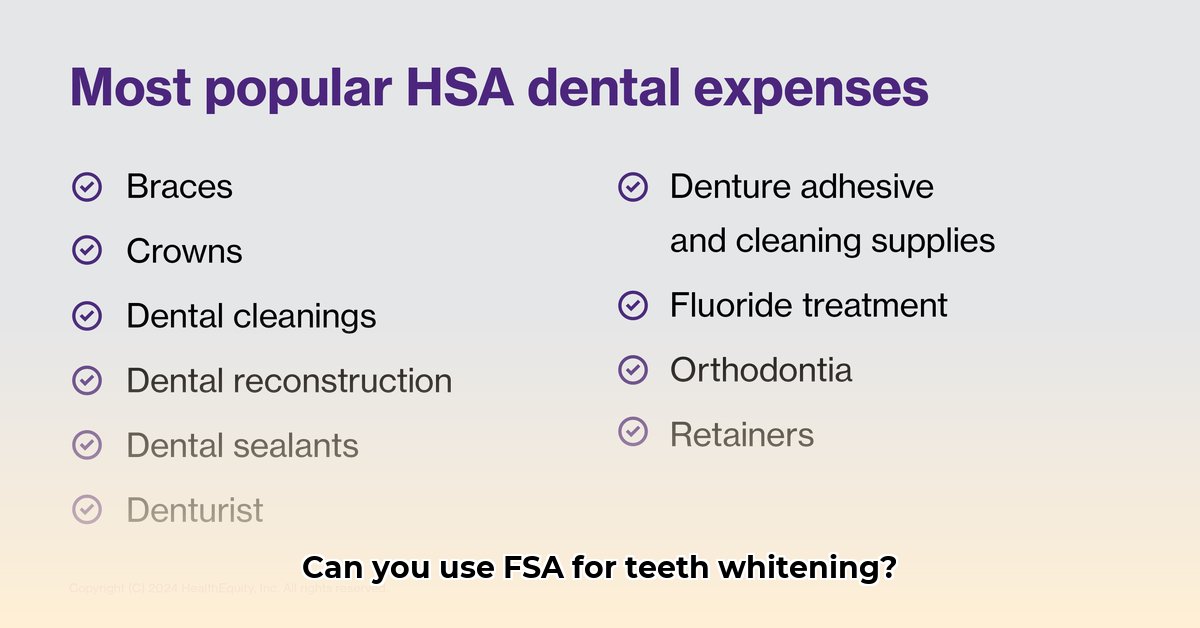
Understanding Flexible Spending Accounts (FSAs)
A Flexible Spending Account (FSA) lets you set aside pre-tax money from your paycheck for eligible healthcare expenses. This reduces your taxable income, saving you money upfront. However, the IRS strictly defines what counts as a "qualified medical expense," and this is where teeth whitening often falls short.
IRS Guidelines on Qualified Medical Expenses
The IRS defines qualified medical expenses as those incurred to diagnose, cure, mitigate, treat, or prevent disease, or to affect any structure or function of the body. Essentially, the expense should address a medical necessity, not simply improve appearance.
Why Teeth Whitening is Usually Not Covered by FSA
Teeth whitening is primarily considered a cosmetic procedure, aimed at improving the aesthetic appearance of teeth. Because it doesn't treat an illness or injury, it typically doesn't meet the IRS's criteria for FSA reimbursement. This applies to both professional in-office and at-home whitening kits.
"The IRS focuses on medical necessity, not cosmetic enhancement," explains Dr. Emily Carter, DDS, a practicing dentist specializing in cosmetic procedures. "While professional teeth whitening involves chemical processes, the primary goal is aesthetic improvement, not the treatment of a disease or defect."
Exceptions and Nuances: The Fine Print
While generally considered cosmetic, there might be rare exceptions. If teeth whitening is a necessary component of a medically necessary procedure (for example, after extensive dental work or to address severe discoloration stemming from a specific medical condition), there might be a chance for reimbursement. However, this is highly unlikely unless you can demonstrate a strong clinical justification. Always check your individual FSA plan for details.
Alternative Financing Options: A Step-by-Step Guide
Don't let the FSA limitations discourage you. Several alternatives can make teeth whitening affordable:
- Dental Savings Plans: Research plans offering discounted rates on various dental procedures, including whitening (potential savings: 10-25%).
- Dentist Payment Plans: Many dentists offer in-house financing options, allowing you to spread the cost across several months (potential benefit: improved budgeting).
- Personal Savings: Budgeting and saving specifically for the procedure eliminates debt concerns (potential benefit: complete financial control).
- Third-Party Financing (e.g., CareCredit): These companies specialize in medical and dental financing but be aware of interest rates (potential downside: added interest expense).
- Budget-Friendly Whitening Options: Over-the-counter whitening strips or toothpastes are cheaper but may offer less dramatic results (potential benefit: significantly lower upfront cost).
Advocacy and Future Possibilities
Patient advocacy groups are working to raise awareness and potentially influence future FSA guidelines. Research is ongoing, and changes might occur if the therapeutic benefits of specific whitening techniques are better established.
Conclusion: Making Informed Decisions
Understanding FSA eligibility for teeth whitening is crucial before proceeding. While it's typically not covered, several effective alternative payment options exist. Careful planning and budgeting can help you achieve your desired smile without incurring unexpected debt. Always check with your FSA provider and dentist to confirm coverage and costs.
Three Pivotal Points:
- Teeth whitening is generally considered a cosmetic procedure, not a medically necessary one.
- FSAs primarily cover medical treatments, not cosmetic enhancements.
- Numerous alternative financing options exist for those wanting teeth whitening.